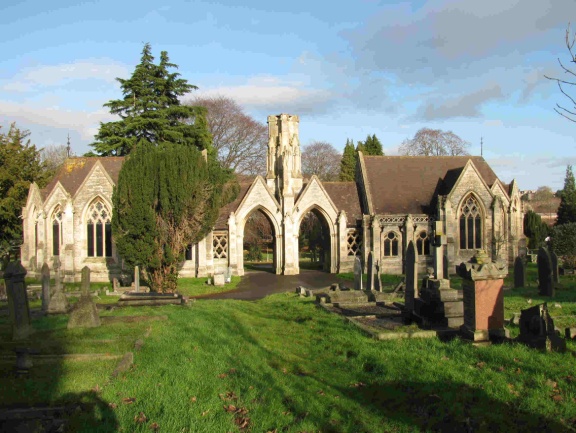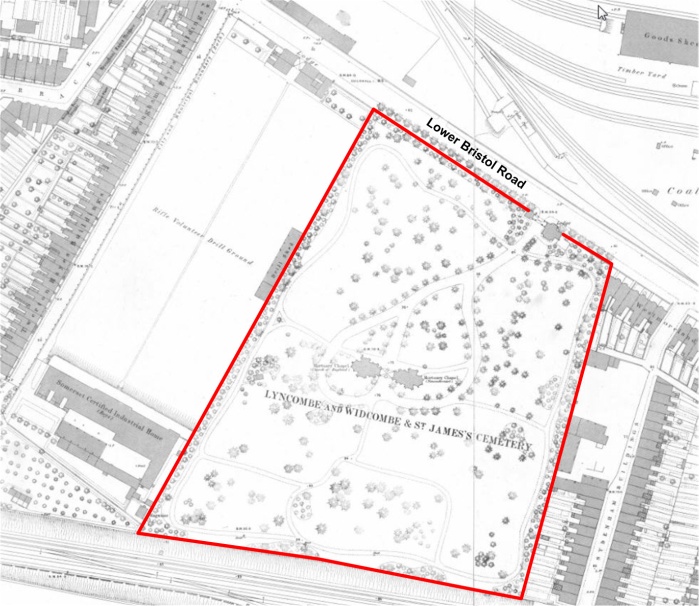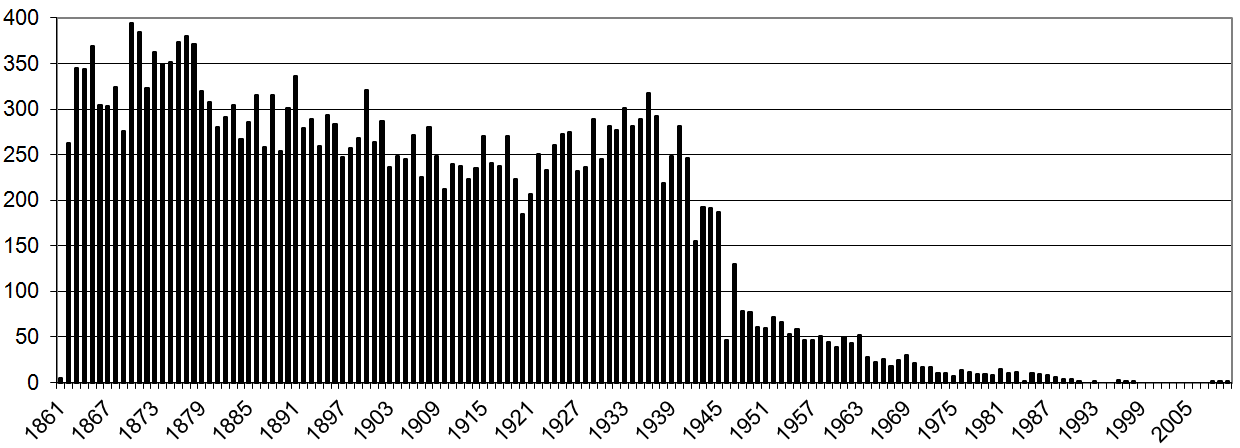 Chapels |  Location |
The cemetery opened in 1861 as Lyncombe & Widcombe’s fourth graveyard and the second graveyard for St James. Instead of being solely an Anglican cemetery it has Anglican and nonconformist chapels and areas and it was administered by a burial board. It is divided into sections labelled A to Z with A starting by the gate and Z by the railway line to the south. Each ‘section’ comprises 7 rows labelled A to G. The numbering of the plots within each row start at 1 on the eastern side of cemetery.
The cemetery is divided into consecrated and unconsecrated parts. In general terms, the plots 1 to about 30 in each row are consecrated and 31 to about 60 unconsecrated. There are exceptions to this general scheme; all plots in sections A to D and T to Z are considered to be consecrated.
There were over 24,000 burials. The graves are aligned in a general east-west orientation. Many are common graves and even some family graves with memorials use plots previously used for burials. High-explosive bombs fell on the north-western part of the cemetery in 1942 and destroyed monuments in that area. Only about 19% of burials have a corresponding memorial.
The burial records are a series of burial register volumes held by Bath & NE Somerset Bereavement Services. Until 2023 these registers were not accessible to the public and access to the index (but not the registers) was only granted under provisions of the Freedom of Information Act. Scanned images of the index were provided by the council on payment of a fee for scanning. It was not permitted to photograph the index. The index volumes have the name, date of burial and burial location. They do not have the ages. To determine the age the corresponding death registration has been used; where an unequivocal match can be made the age has been added. Access to the register is now possible and the records are being progressively updated with the missing information (abodes and places of death, occupations, spouses).
The names appearing on memorials have been documented in the 1980s but not the inscriptions themselves or the locations. These names have been merged with those appearing in the burial register index to indicate, for a burial, whether there is a monument. A survey has been undertaken.
 Overall layout of the Lyncombe & Widcombe and St James’ Cemetery |
 Number of burials per year |
It should be noted that the metal sign to the west of the lodge has 'St James Cemetery' and most press reports of funerals in this cemetery that appear in the Bath Chronicle refer to it in this way. However, the cost of its construction was split between the wards of Lyncombe & Widcombe (61%) and St James (39%) (Bath Chronicle Thu 28 Jul 1859).
Documentation
The burial registers for the cemetery were held by Bath & NE Somerset’s Bereavement Services but have been transferred to Bath Record Office. Originally, in 2012, only indexes to the burial registers, not the registers themselves, were available to volunteers to transcribe. Ages had to be added by finding, if possible, the corresponding General Register Office (GRO) index entry and abodes from entries in the National Probate Calendar, if there was a will. With access to the burial registers, the records are being updated with the missing information. By Aug-2024 the first 10,000 records had been updated with addition of dates of death, abodes and occupations, and ages and plot numbers checked and added or amended.
Indexes for Burials at Lyncombe & Widcombe and St James’ Cemetery, Bath. Widcombe Association. A 2012 draft of the documentation, including name and location indexes, is at Bath Record Office.
Limitations
There remain about 50 memorials to locate. Various memorials found in the survey carried out in the 1980s have yet to be found. A trial on a flat area which should have had a memorial found that the slab was covered by about 10cm depth of turf.
The description of the location of grave has either a C or U suffix to indicate whether consecrated or unconsecrated. This suffix has had to be omitted from the Bath Burial Index because its use was not consistent. Some graves with multiple burials have different suffices for different burials even though in the same grave. Inclusion of the suffix would have indicated a separate grave when this is not the case.